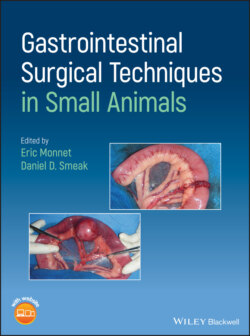Читать книгу Gastrointestinal Surgical Techniques in Small Animals - Группа авторов - Страница 37
2.1.8 Biofragmentable Anastomosis Ring
ОглавлениеThe Bowel Anastomosis Ring (BAR) (Valtrac, Medtronic, Minneapolis, MN) is a biofragmentable medical device made of two interconnecting half‐shells made of polyglycolic acid and barium sulfate (Figure 2.1). The device is designed to facilitate anastomosis of the inverted ends of bowel without suturing. The device is placed without an incision in the cecum or retrograde placement through the rectum. It has been reported for use in human and veterinary colonic anastomoses, but also in small bowel and esophagogastric anastomoses (Corman et al. 1989; Thiede et al. 1998; Ryan et al. 2006). Its size range (21–34 mm) generally limits its use in small animal surgery for colonic and rectal anastomosis in larger breed dogs. Purse‐string sutures are placed with a Furniss clamp at the ends of bowel to be connected and the affected bowel is resected. The purse‐string sutures are tightened individually over the middle of the two interconnecting half‐shells of the BAR. The half‐shells are compressed together and intestinal continuity is restored. The rings gradually dissolve and are shed into the bowel for evacuation. The rate of leakage and stricture formation associated with the BAR is comparable to that reported in the literature for stapled and hand‐sewn colon repairs in humans (Corman et al. 1989). The BAR has been used with success in cats with megacolon (Ryan et al. 2006). The presence of the megacolon allows placement of a 25 mm BAR with 1.5 mm gap between the two‐half after compression. Relaxation of the wall of the colon to facilitate placement of the BAR can be induced with warm saline irrigation, application of topical 1% lidocaine or with IV glucagon (Hardy et al. 1987).
Figure 2.1
